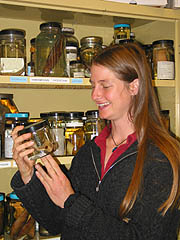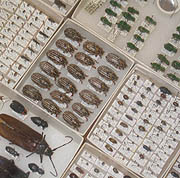|
January 6, 2003
Museum of Natural History Collections aids researchers
campuswide
By Jennifer McNulty
When hungry rodents began devouring the seeds of a rare native plant
that UCSC junior Adrian Deveny is studying at the Fort Ord Nature Reserve,
he knew where to turn for help identifying the critters.
 |
|
Some of the specimens at the Museum of Natural History Collections
date back to the early 1900s. Tonya Haff is senior museum scientist
and curator of the museum. Specimens
include drawers housing an extensive collection of Santa Cruz
County insects, below. Photos: Jennifer McNulty
|
 |
Tucked into a small room on the second floor of Natural Sciences 2,
the UCSC Museum of Natural History Collections is a treasure trove for
anyone eager to learn about plants, animals, birds, and reptiles, especially
those native to the Central Coast of California.
Deveny fashioned a wax cast of paraffin, peanut butter, and oats to
capture the teeth marks of the rodents and set out the tasty "traps"
below the Ceonothus shrubs he's monitoring at the reserve. After the
critters nibbled, Deveny brought the "wax indicators" to the
museum to compare the markings to the teeth of several specimens in
the museum collection. With the help of Maggie Fusari, director of Natural
Reserves, Deveny was able to come up with three preliminary matches:
kangaroo rats, wood rats, and deer mice.
"The kangaroo rat was totally bizarre, because we didn't think
there were any at the reserve," said Deveny, who initially examined
the impacts of grazing deer on the reproductive success of the shrubs.
Looking at the impact of rodents on seed output was an unexpected turn.
"If I didn't have access to those skulls, I would've had to compare
the wax indicators to a book," said Deveny, who's majoring in ecology
and evolutionary biology. Instead, he was able to actually remove the
jaws from the skulls and physically match them to the teeth marks. "The
differences are less than one millimeter, so it has to be really, really
precise," said Deveny, who will use a dissection microscope to
confirm his findings. "With a book, I couldn't have gotten that
exact fit."
Deveny's experience highlights the key role the museum's collection
plays in research virtually every day.
"These collections are so valuable," said Tonya Haff, senior
museum scientist and curator of the museum. "There's nothing like
seeing the real plant or the real animal up close to help you learn
about it and to help you remember the field characteristics."
The museum is the only facility like it on campus, boasting a collection
of more than 50,000 specimens, including some endangered species. Though
not a museum in the popular sense--there are no fancy displays, and
it's not open to the public--the collection is available to UCSC faculty,
students, staff, and researchers. Called a "teaching collection,"
the museum offers one or two specimens of each species in the collection.
The museum was founded in 1994 by curator Jeff Davis, although many
specimens were collected in the 1980s by participants in the Environmental
Studies Field Program. Haff has run the museum for about a year. Today,
faculty in environmental studies and biology use the museum's holdings
during lectures and lab sections, art students and graduate students
in the Science Illustration Program rely heavily on the museum for reference
materials, and researchers turn to the collection for valuable historical
data.
"The museum is indispensable for us," said Jenny Keller,
a lecturer in the Science Illustration Program. "There's nothing
to replace a specimen for providing detail. When we put an insect under
magnification, it becomes this incredible world of color, pattern, and
structure. Those are the kinds of things we like to show people in our
illustrations."
Barry Sinervo, professor of ecology and evolutionary biology, said
he uses the amphibian and reptile collections extensively and "could
not run" his course without the museum. "We're augmenting
the collection all the time," said Sinervo, who hopes to entice
a student into preparing a recently acquired badger carcass as an independent-study
project.
Surrounded by metal cabinets and cases packed with carefully prepared
specimens, some of which date back to the early 1900s, Haff said handling
specimens aids field learning, too. Most students first learn about
a species in a book, but seeing a specimen is an important second step
that helps prepare them for fieldwork.
Cradling a Cinnamon Teal in the palm of her hand, Haff offers a quick
lesson in duck anatomy.
"There are a lot of nuances you can't get from a book--like the
texture of the features, the serration on the bill--that tells you how
they feed, they're strainers--and look at the webbing on the feet. Birds
have several different toe arrangements. See the iridescence on the
feathers?"
Gently opening a paper folio to reveal a delicate plant specimen, Haff
examines the fine penmanship of Miss Kate Conger, who prepared the Allium
sample from Butte County in 1907. "People used to have such nice
handwriting," sighed Haff.
Each quarter, about six undergraduates work with Haff, either as volunteers
or earning independent-study credit, learning the art of preparing animal
and plant specimens, cataloging reptiles and amphibians, and trying
to keep the backlog of specimens awaiting preparation to a minimum.
"There is an endless number of projects," said Haff, opening
a jam-packed freezer to reveal a heap of paper-wrapped fresh specimens.
"There's a huge backlog of things to be done."
Haff, who works 30 hours a week, runs the museum on a shoestring budget
of about $1,000 a year that covers the cost of supplies, such as ethyl
alcohol and herbarium paper. She hopes to make the museum's collection
available to more people by creating an online catalog of its contents.
Right now, about 80 percent of the collection has been cataloged. "We
need a web site," said Haff. "That's my top priority. A museum
functions like a library--it's hard to use if you don't know what's
available and you have to ask a librarian about every single thing."
In the meantime, Haff offers tours of the museum to classes, and she
oversees lab sessions held next door. It is illegal to kill native wildlife,
so the collection is growing largely through donations from similar
institutions, from individuals, and through salvage collection. Haff
has a salvage permit from the California Department of Fish and Game
that allows her to collect carcasses that are killed on roadways, for
example.
Community members have made significant contributions to the collection,
from the blond pocket gopher that's an outstanding example of variation
within a species to the vast collection of Santa Cruz County insects
collected over a 10-year period by local biologist Randy Morgan. UCSC
is fortunate to be housing part of Morgan's impressive research collection,
said Haff, opening drawer after drawer packed with shiny beetles, delicate
dragonflies, and tiny ants.
"It's a huge database," Haff said of the 20,000 specimens
Morgan has loaned the campus, complete with detailed field notes about
each insect. "Once it's cataloged and available, it will be quite
useful to students doing research on local insects."
Return to Front Page
|